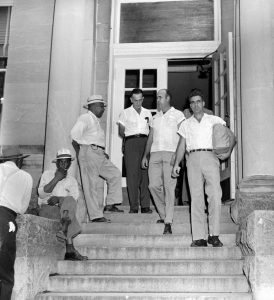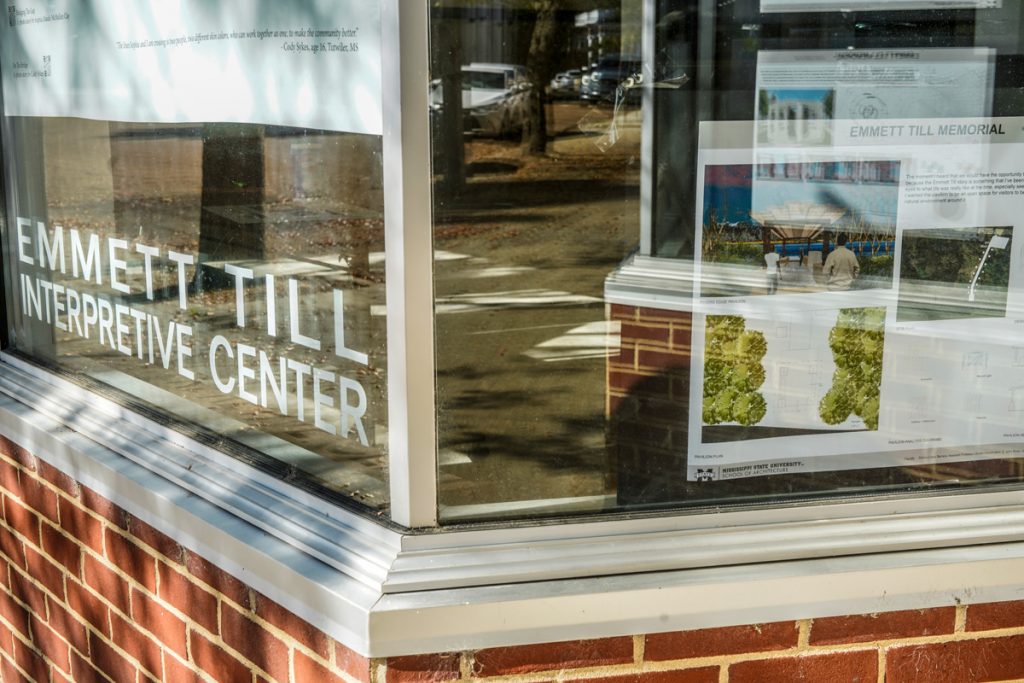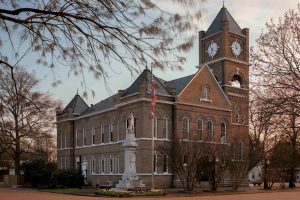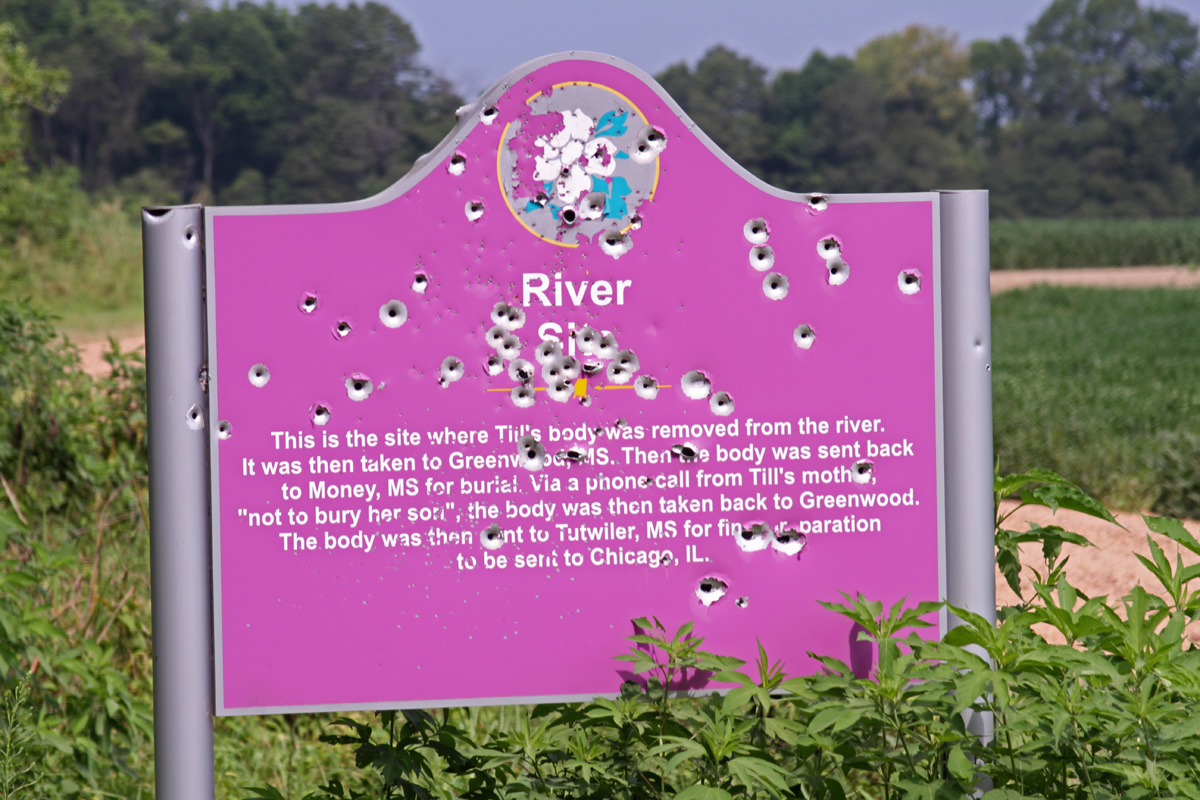In March 2019, a group of college students made the hour-and-a-half long drive from Oxford, Miss., to Glendora, Miss., a small Delta town that borders the Tallahatchie River. The students soon located their target—the “River Site” sign, which is the eighth stop on the Tallahatchie Civil Rights Driving Tour.
The purple sign commemorates a tragic moment in Mississippi history, as the marker at Sharkey Bridge signals the spot where Emmett Till’s body was pulled from the river. The 14-year-old’s body told the story of his fate, bearing the unmistakable markings of a severe beating and a gunshot wound to the head. His murderers had also used barbed wire to tie the Chicago boy’s body to a metal fan.

Cavalierly disregarding the sign’s retelling of the gruesome event, the University of Mississippi students posed beside the sign, riddled with bullet holes, showing off their weapons in the glare of headlights that cut through the same darkness that had swallowed Till 64 years earlier. One of the students snapped a photo, and another posted it to his Instagram account, leading to a national outcry—putting the hundred-person town of Money, Miss., at the center of a national hailstorm for the second time in its history.
Elevating Till’s Life and Legacy: An ‘Ongoing Process’
Five months later, in August 2019, Benjamin Saulsberry, the director of the Emmett Till Interpretive Center in nearby Sumner, was giving a tour of the courtroom where Emmett Till’s murderers had been acquitted of their crime after only 68 minutes of jury deliberations. The all-white jury thus exempted J.W. Milam and Roy Bryant ever being tried again, despite the fact that they would confess to the murder in an interview with Look magazine just one year later.
An audience member hung back after the tour and expressed an interest in forming a partnership between the Emmett Till Interpretive Center, which was founded in 2015 to “tell the story of the Emmett Till tragedy and to point a way towards racial healing,” and his own employer: the Andrew W. Mellon Foundation, which has an endowment of $6.1 billion.

The visit was sheer serendipity for Saulsberry, who was having what he considered a normal day at the office. “We were doing what we always do, sharing about the memory of Emmett Till and (his mother) Mamie Till-Mobley, and we always talk about how that narrative impacted and impacts our community,” Saulsberry says of the chance meeting.
The Mellon Foundation just announced a $691,000 grant to enable the Emmett Till Interpretive Center to continue to share its narrative of racial reconciliation. In a statement regarding the receipt of funds, Elizabeth Alexander, the president of the Mellon Foundation, commented on the center’s work, saying, “Monuments and memorials powerfully shape our understanding of our country’s past and determine which narratives we honor and celebrate in the American story. Future generations ought to inherit an inclusive commemorative landscape.”
Saulsberry acknowledges that the roll-out of the grant is in its “infant stages,” but says the Center aims to expand its outreach to neighboring communities, to foster opportunities for youth engagement and to potentially hire new staff members.
“We know it’s important that we create a strategic planning process,” Saulberry reflects. “We’re figuring out the best ways to do that. It’s the more immediate of our intentions this year, and it may be an ongoing process.”
The work of elevating the life and legacy of Emmett Till has itself been an “ongoing process,” as many historians cite the murder—and Mamie Till-Mobley’s insistence that the nation look upon her son’s disfigured face as evidence of what whate supremacy had wrought—as the spark that ignited the Civil Rights Movement.
‘A Biracial, Citizen-Driven Initiative’
Benjamin Saulsberry believes that the work began in earnest in 2007 with the creation of the Emmett Till Memorial Commission. “It was a biracial, citizen-driven initiative,” Saulsberry says of the original talks, which the William Winter Institute for Racial Reconciliation facilitated, and the late Jerome Little spearheaded.
These original discussions culminated in an official apology to members of the Till family, with the citizens of Tallahatchie County “recognizing that the Emmett Till case was a terrible miscarriage of justice.” The apology went on to acknowledge that the legacy of the crime “haunted the community” before concluding, “We need to understand the system that encouraged these events and others like them to occur so that we can ensure that it never happens again.”

Saulsberry well remembers the 2007 apology—given over half a century after Till’s murder—saying,“The apology was read by the Commission’s then co-chair, Betty Pearson. A few of (Till’s family members) were in the audience that day. (Till’s cousin) Simeon Wright spoke on behalf of the family, accepting the apology, but (the event) called for Mississippi to look at our past and to do the work.”
The museum director believes that any true examination of the past must extend beyond the borders of Mississippi. “We shy away from the truth,” he asserts. “When we do that, we’re robbing ourselves of the opportunity to be better. Mississippi has this weight—and this national perspective—of being so bad and so racist, and in some ways, Mississippi hasn’t done a great job of ridding itself of such a title.”
He maintains that even the negative aspects of Mississippi’s long struggle with racial reconciliation serve as a seedbed for the Emmett Till Interpretive Center’s work to educate the public. “There are other truths about Mississippi,” Saulsberry says. “People care greatly about the health and wellness of our state. We have had to endure this, but we are not at the mercy of our past and the poor decisions made.”

The poor decisions of many still pockmark the farmland where Emmett Till lived and died, as Carolyn Bryant Donham acknowledged in a 2017 interview with historian Timothy B. Tyson that she had lied about Till sexually harassing her, though the admission came long after the five-year statute of limitations on perjury. The sign that the University of Mississippi students leered beside was replaced due to continued vandalism three separate times before a 500-pound, steel marker was installed in its place, armed with alarms.
“If the work was only building up signs when they were torn down, it would be hard,” Saulsberry concludes. “But that’s not the only work. It affirms why we do what we do, and it shows why the Emmett Till Interpretive Center exists. It shows what it takes to build healthy relationships, what it takes to be heard and not judged. You’ll always have some folks who won’t agree with you and who will take that course of action, but that further compels us.”
Those who are interested in participating in the Emmett Till Interpretive Center’s strategic planning process as it relates to the Mellon grant may email info@emmett-till.org.






